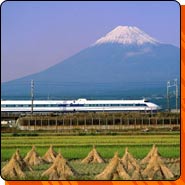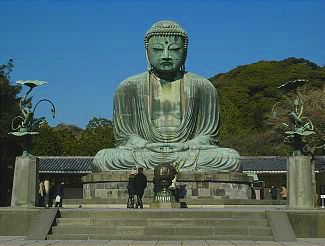| Nozomi (superbullet) Train |

|
| Mt Fuji in background |
| Great buddha of Kamakura |

|
| Built in 1252 |
- Apr 29. Arrive Narita Airport, Tokyo via American Airlines. Met by Izumi at airport, took the Sobu JR commuter
train to Shin- Kawasacki station in the south west sector of Tokyo, across the river from Izumi's apartment, a 4th floor,
1bedroom. Noted with amazement the array of high tech flourishes, including both heating and cooling on the same panel.
- Apr 30. Day of relaxation. Weather hot and dry, not as we expected from Yahoo Weather. In the afternoon we
joined Yoko and Massa -parents- for a walk up and down the river. He indicated the twin towers of Nippon Electric, a sister
company of Sumimoto Mining, where he worked until recently. The excited cries of the high school baseball team, working out
beside the river outside our apartment, resounded in our ears all day long.
- May 1. Tokyo. Went with Izumi to Ueno Park to Tokyo National Museum, a survey of Japanese art from neolithic
times. Saw the gallery of Horyu-ji treasures, great bells, painted screens, gigaku dance masks of
the 8th century and spectacular, colorful kimonas.
- May 2. To Kyoto by Nozomi (fast bullet train) with Izumi and her niece. Up to 200 miles per hour, but stable
and noiseless by virtue of its all welded track. Stayed in the Kyoto Tokyu hotel with a beautiful waterfall in the entrance
foyer.
- May 3. Kyoto. By taxi to FUSHIMI SHRINE, located at the base of wooded hills, with paths overhung with orange
torii stretching for miles in the woods. These torii must have been the inspiration for the orange Gates set up by Christo
and his wife in Central Park. A visit to the TOJI TEMPLE with an important collection of ancient Shingon Buddhist
art, including the cosmic Buddha and fierce-looking gods. NANZEN-JI, the essence of Kyoto, according to many observers. A
Zen Buddhist abbots monastery, which includes wonderful stone gardens--minature trees, moss and ancient stones set in a base
of raked gravel. We had tea while observing a waterfall. Especially notable were the elegant sliding doors by the
Kano school. Tigers, cranes, cherry blossoms on the doors.
- May 4. By train to Nara. Bad luck. Spent too much time in a taxi immobilized by gigantic traffic jams. Visited
TODAI-JI. Site of an enormous Buddha built in 752. The great Buddhas head fell off in an earthquake in 855. Awesome. It has
lost its two great pagodas, but they have rebuilt the spire of the pagodas, which is set off to one side in the woods.
KOFUKU=JI. Ashura statue, one of the eight guardians of Buddhism, from the 8th century in Treasure House.
Great pagoda from the 15th century.
- May 5. Visit NIJO CASTLE in Kyoto, created by Tokogawa Ieyasu in 15th century. Home
of the shoguns, the military rulers of Japan until the middle of the 19th century. Notable: the Nightingale floors--their
squeaking warned of intruders; the tiger scenes on the screens, the beautiful Kano paintings of trees populated by peacocks
and swallows, the grand chamber where the shogun met the daimyo lords--so spare, absolutely no furniture. Then
back to Tokyo on the Nozomi train. Invited by the parents to the westernized SAINT MARCO restaurant--saw only knives
and forks--along the river. We had lamb stew, a California chardonnay, and many tasty small dishes. Incredible selection of
hot rolls.
- May 6. Tokyo. Weather turns rainy and cold. Taken around on a museum tour of Tokyo by Momoyama, a former
PhD student of Marian's at NYU. SEIJI TOGO MEMORIAL SAMPO JAPAN MUSEUM OF ART in Shinjuku on a high floor with great view
of Tokyo. Exhibition of paintings from Montpellier, including van Gogh, Courbet. NATIONAL MUSEUM OF MODERN ART TOKYO across
from the Imperial Palace, Rousseau, Juan Gris, Kandinsky. Elegant lunch with Masao in the museum. BRIDGESTONE MUSEUM OF ART.
European and Japanese paingings collected by the founder of the Bridgestone Tire Co. Elegant museum with European artists--
Arp, Matisse, Monet, Picasso. EDO TOKYO MUSEUM. The history of Tokyo told through a series of scaled models of the shoguns
palace and its environs. Also an exhibition of mummies and artifacts found in western China along the Silk Route.
- May 7. Day of relaxation. Tea with Izumi and Yasoko Hamada. Marian produced her famous
cucumber sandwiches. Ms Hamada is an expert in Russian icons, She will take us to Kamakura on Tuesday.
- May 8. From Tokyo, off to Gotenba, a village in the foothills of Mt Fuji as guest of Izumi's parents.
Arrived at the Keidanren Guest House in mid afternoon after a series of rides in taxis, subways, and trains.
Surprise in a country jammed with people--we were the only guests in the hotel. That day the peak of Mt Fuji was obscured
with clouds, but we were assured by the waiter at a sumptious dinner that the peak would be visible next morning.
- May 9. In the guesthouse just below Mt Fuji. We saw the peak at breakfast for a
few fleeting minutes. It stands high and majestic, with a volcanic crater at its peak and strips of snow showing on its flanks.
Then the clouds closed in again. Circled the guest house, admiring the azealeas, the cherry trees in blossom, and a georgeous
unknown purple tree. Then we took a taxi to Lake Kawaguchi, where we circled the lake in a house boat. Noted a beautiful wooded
island with a small shrine near the shoreline. Lunch of udon and miso broth on the lakeshore.
- May 10. Off to Kamakura. Yasoko Hamada, expert in Russian ikons, guides us to Kamakura
and Hayama, a small seaside town where we snaked through the narrow streets on a bus. Shown around the Museum of Modern Art
in Hayama, by Masao Momiyama, who is a curator in the museum. Exhibit of works by Kataoka Tamako, a 100 year old woman
artist, still alive and working. Many portraits of famous Japanese artists, in colorful traditional robes, side by side with
a copy of one of their masterpieces. Delicious luncheon in the museum restaurant on a terrace overlooking the Pacific
Ocean. Then a taxi to another Great bronze Buddha in Kamakura. Originally placed in a huge building, the temple was swept
away by a tidal wave in 1495, leaving the Buddha sitting alone. The image is of Amida, the merciful Buddha. Visit
the Hasadera, a temple holding the image of a 9 meter Kannon. Visited a cave with thousands of tiny statues of babies, representing
the unborn (aborted) children.
- May 11. Day of relaxation. Walked along the riverside for a few hours with Yoko and Massa. Interupted the
walk with a snack at a restaurant. This everning a last supper at the C`est La Vie restaurant, a sumptious prix
fixe dinner in a French restaurant. Seven courses, including a cheese pan, seafood, chicken, fish,
filet de boeuf, desert, coffee.
- May 12. End of holiday. Sob! Back to NY from Narita by American Air.
- Notes
- Money--best exchange rate is obtained by taking travelers checks into Japan and exchanging them for yen at the airport.
Exchange rate 7 % better than that obtained either in a NY bank or JFK money exchange. Japanese hotels also give good rates,
but you must be a guest. Contradicts all advice I got from friends, travel agents, etc.
- How to get from Narita Airport to Shin-Kawasacki train station. Take the Sobu Line, which changes into the Yukosuka Line,
directly from the airport. Cheap and direct. Every adviser, including internet, tourist office, etc. tells you to go to downtown
Tokyo, then change for the express train. More expensive, time-consuming, and nerve-racking with luggage.
- Tokyo is a place of $6 to $7 cups of coffee. Makes Starbucks look cheap.
- Getting around Tokyo remains one of our unsolved problems. Years ago, when I was here, it was a simpler problem.
Then you could buy a round trip ticket at the window and follow directions. Now, tickets must be purchased from
a vending machine, where most, if not all of the directions are in Japanese.Why not buy a day or week pass? Not generally
useful, because there are two or three private lines as well, none of which accept JR tickets. Even Tokyoites must
think two or three times before stepping up to the machine.
- Was pleasantly surprised by the lack of crowding. Except in one or two cases, when the school kids were released, we had
no great problems with overcrowding. None of those shoving, pack-em-in tactics we`ve seen in movies. All of the stations
we visited were clean, well-lit and colorful. The advertising (visible everywhere) often cleverly interlace writing
with photos to produce an elegant pattern.
|



